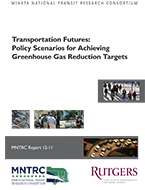- 408-924-7560
- mineta-institute@sjsu.edu
- Donate
Transportation Futures: Policy Scenarios for Achieving Greenhouse Gas Reduction Targets
It is well established that GHG emissions must be reduced by 50% to 80% by 2050 in order to limit global temperature increase to 2°C. Achieving reductions of this magnitude in the transportation sector is a challenge and requires a multitude of policies and technology options. The research presented here analyzes three scenarios: changes in the perceived price of travel, land-use intensification, and increases in transit. Elasticity estimates are derived using an activity-based travel model for the state of California and broadly representative of the U.S. The VISION model is used to forecast changes in technology and fuel options that are currently forecast to occur in the U.S., providing a life cycle GHG forecast for the road transportation sector. Results suggest that aggressive policy action is needed, especially pricing policies, but also more on the technology side. Medium- and heavy-duty vehicles are in particular need of additional fuel or technology-based GHG reductions.
ANDREW I. KAY, MCRP
Andrew I. Kay is a research manager at the Voorhees Transportation Center. His research interests focus on the interactions between transportation systems, land use, and environmental outcomes. He has contributed to numerous studies that apply quantitative methods and GIS analysis to issues in transportation planning and policy at the local, state, and national levels. Mr. Kay received his Master of City and Regional Planning degree from the Edward J. Bloustein School of Planning and Public Policy at Rutgers University in 2010, along with a Certificate of Transportation Studies. He also holds a Bachelor of Arts in Philosophy from the New College of Florida.
ROBERT B. NOLAND, PhD
Robert B. Noland is a professor at the Edward J. Bloustein School of Planning and Public Policy and serves as the director of the Alan M. Voorhees Transportation Center. He received his PhD in Energy Management and Environmental Policy from the University of Pennsylvania. Prior to joining Rutgers University, he was Reader in Transport and Environmental Policy at Imperial College London, a policy analyst at the U.S. Environmental Protection Agency, and he also conducted postdoctoral research in the Economics Department at the University of California, Irvine. The focus of Dr. Noland’s research is the impacts of transport planning and policy on both economic and environmental outcomes. Work on economic effects has included examining behavioral reactions to changes in reliability, associations with the built environment, and trip-chaining behavior. Environmental work includes impacts on safety, climate, health, and other factors associated with overall quality of life. Active research areas include developing methods to evaluate the life cycle greenhouse gas emissions associated with building transport projects; evaluating the economic impacts of transit-oriented development; analysis of walking behavior and links to other travel behavior and the built environment; analysis of traffic and pedestrian safety using spatial analysis techniques; and, assessment of the economic effects of transport investments, in particular those associated with agglomeration externalities. Dr. Noland’s research has been cited throughout the world in debates over transport infrastructure planning and environmental assessment of new infrastructure. Dr. Noland is currently Associate Editor of Transportation Research-D (Transport and Environment) and the International Journal of Sustainable Transportation and Chair of the Transportation Research Board Special Task Force on Climate Change and Energy.
CAROLINE J. RODIER, PhD
Dr. Caroline Rodier is a research associate at the Mineta Transportation Institute and Associate Director of the Urban Land Use and Transportation Center at the University of California, Davis. Her major areas of research include transportation and environmental planning and policy analysis. Dr. Rodier has extensive experience applying land-use and transportation models to explore both their promise and limits to inform public investment, planning, and policy decisions. At the University of California, Davis, she managed the development of activity-based microsimulation models for the State of California and the San Joaquin Valley. She is currently applying these models to investigate demand management policy synergisms, performance measurement, and policy effects on interregional and commercial vehicle travel. Previously, as a senior researcher at the Transportation Sustainability Research Center at the University of California, Berkeley, she lead research evaluations of parking information, pricing technologies, and shared-use modes to facilitate first- and last-mile access to transit. She currently serves at Chair of the Transportation Research Board’s Emerging and Innovative Public Transport and Technologies Committee. She holds a PhD in Ecology and an M.S. in Community Development from the University of California, Davis, and a B.A. in U.S. History from Barnard College, Columbia University.
-
Contact Us
San José State University One Washington Square, San Jose, CA 95192 Phone: 408-924-7560 Email: mineta-institute@sjsu.edu






